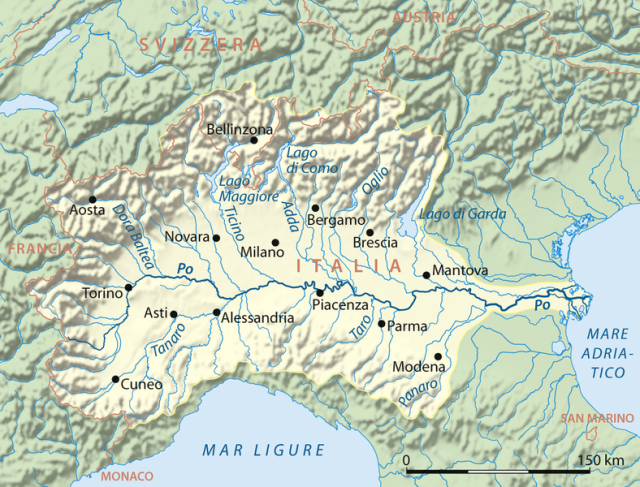Po Valley
THE PO RIVER VALLEY is the largest and most important economic region in ITALY. It is the center of most Italian industry as well as Italy's agricultural heartland. More than 16 million people—nearly a third of all Italians—live in this fertile basin, in which are located 12 cities with populations surpassing 100,000, including Turin and Milan, with populations over 1 million.
The river itself is not among the longest rivers in Europe, running 405 mi (652 km) from west to east, but together with its 141 tributaries, the Po catchment area stretches across 27,000 square mi (70,000 square km). The river's agricultural and industrial importance has played a primary part in the political and social history of Italy—the basin today accounts for 40 percent of the nation's gross domestic product—but suffers serious environmental consequences through poor water management, industrial and sewage pollution, and agricultural runoff.

The Po River, called the “Padus” in Latin—the origin of the term Val Padana (“Po Valley”)—begins as a swift mountain stream in the Cottian Alps on the border with FRANCE, near the peak of Monviso (12,602 ft or 3,841 m). It flows east and north to Turin, a major manufacturing town, then continues east across the Piedmont region, joined by several small rivers flowing down from the ALPS to the west or north. Near Alessandria, it is joined by the river Tamaro, which flows from the south, originating in the Apennines. From this point east, the Po's tributaries continue to be differentiated between those that flow from the Alps to the north and those that rise to the south in the Apennines, with very different characteristics, notably, differences in seasonal flood patterns.
The major Alpine tributaries are (from west to east): the Ticino, Adda, Oglio and Mincio. The headwaters of these rivers generally form the northern boundary of Italy with SWITZERLAND, with the exception of the Ticino, which flows through the southern Swiss canton of the same name. Each of these rivers also flows through a major lake at the point at which the mountains reach the upper Po Valley Plateau (also from west to east): Maggiore, Lugano, Como, Iseo and Garda. These lakes are popular among tourists for their cool climate and rich mountain scenery. The major cities in this region, north of the Po, are located between the major rivers: Novara, Milan, Monza, Bergamo and Brescia, plus the smaller but important historic cities of Cremona and Mantova (Mantua).
The major rivers that flow from the Apennines to the south—usually swifter and with heavier sediment—are (from west to east) the Trebbia, Taro, and Secchia. Major cities on these rivers are Piacenza, Parma, Reggio nell'Emilia, and Modena. The last 75 mi (120 km) of the Po Valley is a narrow corridor to a broad delta on the ADRIATIC, in which the main city is Ferrara. Two other river basins hem in this corridor to the north and south, whose mouths are so close to those of the Po that they can really almost be considered part of the same drainage basin: the Adige, which drains much of the Veneto and northeastern Italy, and the Reno, which collects several of the rivers of Romagna. If these basins are included within the wider Po Valley, even more famous Italian cities can be added to the list, including Bologna and Verona.
IRRIGATION
Parts of the Po River Delta and the Val Padana have been drained for agricultural purposes since Roman times. The Po Valley is Europe's largest rice-growing region, requiring significant amounts of water to be diverted from the river and its tributaries, but even larger amounts of water are diverted for industrial purposes, for example, for the large automotive industry in Turin.
Flooding has always been a major issue in the Po Valley, especially in spring when melted snow and ice from the Alps can double the river's flow within hours. Extensive dykes and levees have been built to curb this problem, along with river straightening projects to aid navigation, but these have mostly served to shift the flooding along to other parts of the river. In 1989, the Italian Parliament created several new bodies to oversee water management throughout the country; the largest of these was created for the Po River Basin.
This agency has the monumental task of restoring the environmental balance of the Po and its tributaries while maintaining the viability of 269 hydroelectric plants, 11 thermal power plants, farming activity that accounts for 35 percent of Italy's gross domestic product, and nearly 40 percent of Italy's industry.